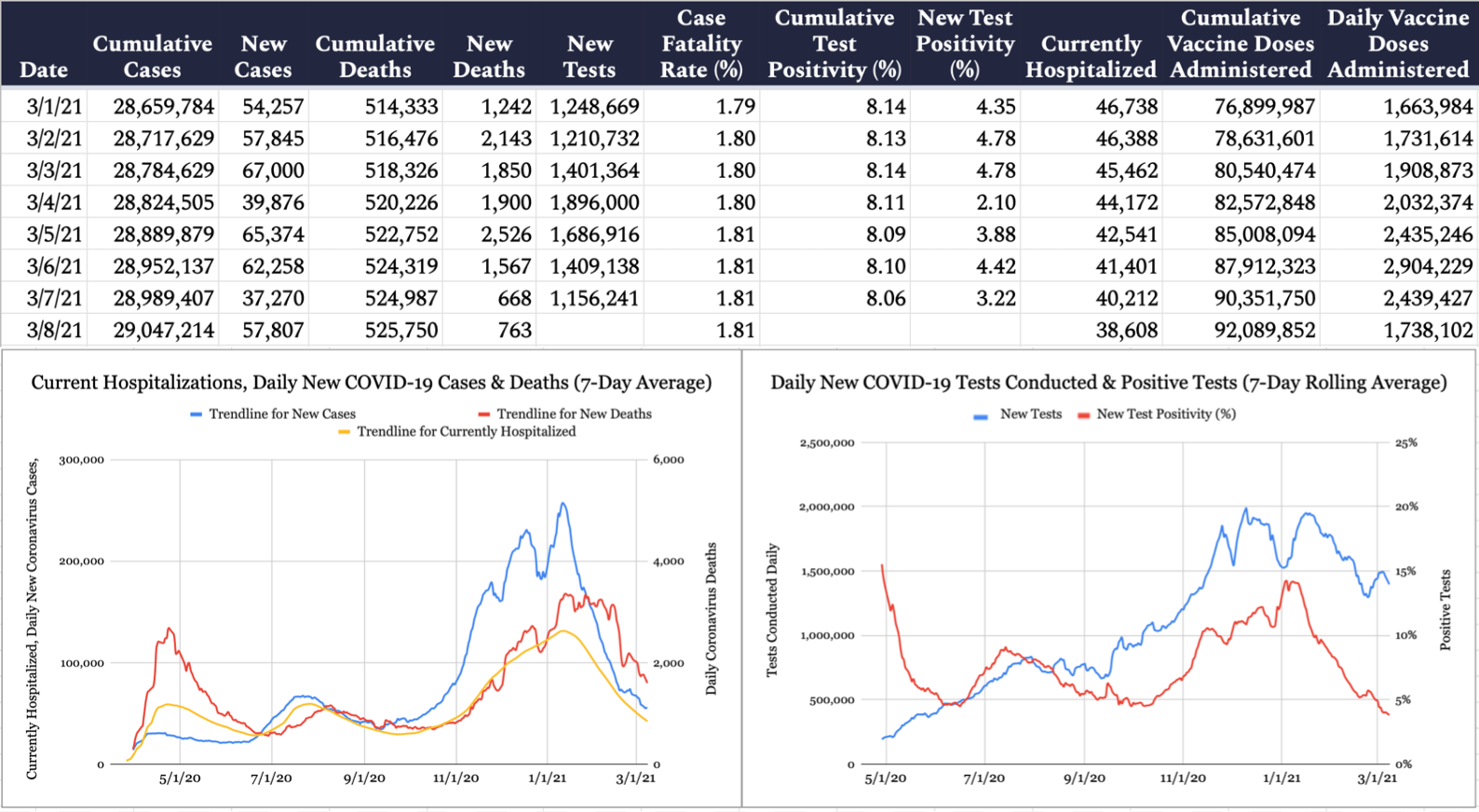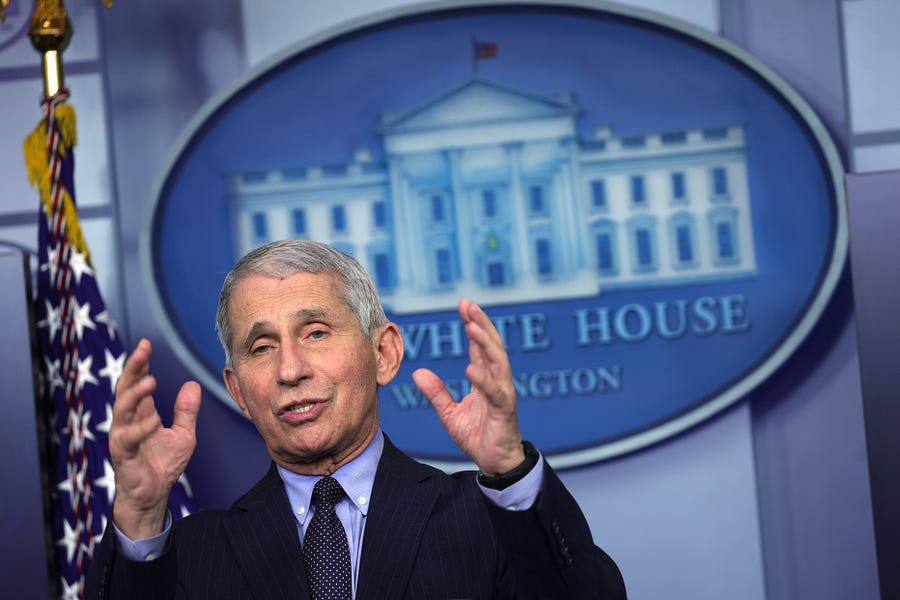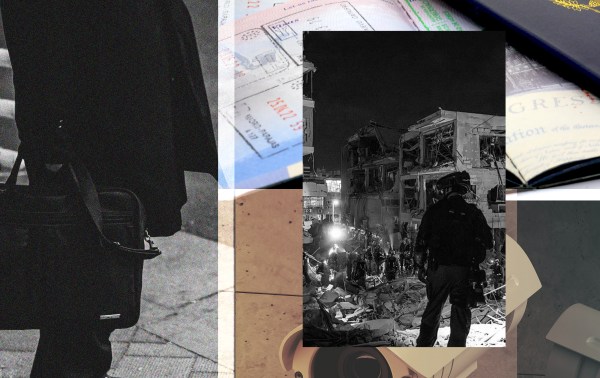Happy Tuesday! Chicago Mayor Lori Lightfoot announced yesterday that Wrigley Field will be able to open at 20 percent capacity when the Cubs season starts next month. Chicago-area TMDer meetup one day?
Quick Hits: Today’s Top Stories
-
The Centers for Disease Control released new guidance for fully vaccinated individuals on Monday, saying they no longer have to wear masks or socially distance indoors when around other fully vaccinated individuals or those not at high risk for a severe case of COVID-19. The CDC’s standard COVID-19 protocols remain the same for vaccinated individuals while in public.
-
Sen. Roy Blunt, a Republican from Missouri and a member of Senate GOP leadership, announced Monday that he will not seek re-election in 2022, becoming the fifth incumbent Senate Republican to do so.
-
The Biden administration on Monday granted 18 months of temporary protective status to undocumented immigrants from Venezuela currently living in the United States, saying the country was “unable to protect its own citizens.” The move—which follows a similar Trump administration action—would allow as many as 320,000 Venezuelan nationals to receive work permits and be exempt from deportation.
-
In a letter to Afghan president Ashraf Ghani, Secretary of State Antony Blinken proposed a United Nations-led effort to broker peace in Afghanistan, making clear that the United States is still considering a “full withdrawal” of its armed forces by May 1 as per the Trump administration’s agreement with the Taliban last year.
-
The United States confirmed 57,807 new cases of COVID-19 yesterday per the Johns Hopkins University COVID-19 Dashboard, with 3.2 percent of the 1,156,241 tests reported coming back positive. An additional 763 deaths were attributed to the virus on Monday, bringing the pandemic’s American death toll to 525,750. According to the Centers for Disease Control, 38,608 Americans are currently hospitalized with COVID-19, and 1,738,102 COVID-19 vaccine doses were administered on Monday, bringing the nationwide total to 92,089,852. The COVID Tracking Project announced yesterday it is closing up shop after a year of data collection, so we will need to find an alternative for some of our statistics.

Vaccine Guidance
Nearly 31.5 million Americans are fully vaccinated against COVID-19, and the benefits of their injections are coming into focus—at least officially.
In its long-awaited guidance for fully vaccinated Americans published Monday, the Centers for Disease Control (CDC) said the lucky 31.5 million can safely gather with each other sans masks or social distancing, and do the same with unvaccinated people from a single household who are not at high risk for a severe bout of COVID. The agency also says vaccinated individuals do not need to quarantine after being exposed to the virus, unless they experience symptoms.
The CDC continues to recommend, however, that fully vaccinated individuals wear masks and practice distancing when in public or when visiting someone with pre-existing conditions. And the agency’s guidance on limiting travel remains unchanged, even for the fully vaccinated.
How does the CDC define “fully vaccinated” in this context? Individuals who have received both doses of the Pfizer/Moderna vaccines or one dose of the Johnson & Johnson vaccine qualify for the updated guidance—two weeks after the last jab.
Once people hit that mark, the CDC’s relaxed guidelines go into effect. “A growing body of evidence suggests that fully vaccinated people are less likely to have asymptomatic infection and potentially less likely to transmit SARS-CoV-2 to others,” the guidelines read. “How long vaccine protection lasts and how much vaccines protect against emerging SARS-CoV-2 variants are still under investigation. Until more is known and vaccination coverage increases, some prevention measures will continue to be necessary for all people, regardless of vaccination status. However, the benefits of reducing social isolation and relaxing some measures such as quarantine requirements may outweigh the residual risk of fully vaccinated people becoming ill with COVID-19 or transmitting SARS-CoV-2 to others.”
What does all this mean in layman’s terms? “Grandparents can hug their grandchildren,” says Dr. Paul Offit, a virologist at the Children’s Hospital of Philadelphia.
Dr. William Schaffner, an infectious disease specialist at Vanderbilt University, welcomed the new protocols. “It certainly is a step towards a slow and careful transition back to a new normal,” he told The Dispatch.
Slow and careful has been the name of the game for the Biden administration’s COVID-19 response since taking office in January. From public health officials like Dr. Anthony Fauci to the president himself, the White House line has consistently erred on the side of caution when it comes to the virus. In an interview with CBS News over the weekend, for example, Fauci briefly acknowledged the dramatic drop in new COVID cases before expressing concern about a potential fourth spike.
“Although the cases are coming down very nicely … over the past week and a half or so, we’ve seen that that decline [is] … starting to plateau,” he said. “We will be pulling back on these mitigation methods. It’s not going to be this way indefinitely for sure. We want to get the levels of virus very, very low, and then we will have much, much easier time to safely pull back and get the economy and all the other things that we want to be normal.”
Fauci is correct that the rate of decline in new cases has slowed in recent weeks, but his cautious approach comes with its own set of risks. “Public health guidance needs to take into consideration what people want to do,” former Food and Drug Administration Commissioner Scott Gottlieb argued on CBS’s Face the Nation on Sunday. “We can’t be so far behind the aspirations of the public that the guidance itself gets ignored. I think people are rightly sensing that vulnerability overall is declining right now as you see more and more people get vaccinated, as we have more population-wide immunity from this virus from prior infection as well.”
In other words, if CDC guidelines remain too strict for too long, Americans will begin tuning the agency out entirely—if they haven’t already. We all have experience doing this: The CDC’s salmonella guidance tells Americans never to eat raw cake batter or cookie dough.
But Monday’s vaccine guidelines are a positive step, particularly as the United States is expected to shift in coming weeks from a shortage of vaccine supply to a shortage of vaccine demand. More than 92 million vaccine doses have been administered nationwide, with just under a quarter of Americans over the age of 18 receiving at least one jab. And the pace is accelerating: Two weeks ago, we were vaccinating a rolling average of 1.3 million people per day. Yesterday, that figure was 2.2 million. The United States has administered about as many vaccine doses thus far as China and the European Union combined.
“Right now there’s not enough vaccine, so we haven’t revealed the real next problem, which is people who refuse to take the vaccine,” said Offit, adding that vaccine hesitancy predates COVID-19 by decades. “I like that story about how Russia is supposedly seeding misinformation about vaccines. Hey—we can do that ourselves, we’re good at that.”
Offit is right that there’s plenty of vaccine misinformation out there—just check the Dispatch Fact Check every few days and there’ll be something new—and it’s having an effect. A Pew survey last week found that 30 percent of Americans still say they probably or definitely will not get a COVID-19 vaccine—although that figure is down from 49 percent in October and 39 percent in November.
The sweeping, $1.9 trillion American Rescue Plan recently passed by the Senate allocates $1 billion toward “strengthen[ing] vaccine confidence.” Expect Monday’s guidance—“get your vaccine, hug your grandkid”—to feature heavily in the marketing campaigns.
The Academic Freedom Alliance
If you’ve been reading The Dispatch for any length of time, you’ve probably caught on to our concern about the intolerance for heterodox thinking that’s working through many of our cultural institutions—academia in particular. So we wanted to highlight the creation of a new organization that has been set up expressly to push back against that wave of illiberalism: The Academic Freedom Alliance, which launched this week with the goal of defending professorial speech around the country.
According to Keith Whittington, a professor of politics at Princeton University and the group’s academic chair, the Alliance “boasts a broad and diverse coalition of over 200 academics from across the country who are committed to upholding the principles of free speech in academia.”
Complaints about the increasingly stifling nature of academic culture and the damage that culture does to free speech aren’t a new phenomenon. But the new organization—following in the footsteps of groups like the American Civil Liberties Union and the Foundation for Individual Rights in Education—aims to give teeth to those complaints by providing legal support in cases where professors’ “academic freedom is threatened by institutions’ or officials’ violations of constitutional, statutory, contractual, or school-based rights.”
In recent months, a growing grievance of the right-wing punditocracy has been so-called “cancel culture”—a messy term that attempts to sweep together acts of censorship by social media companies or government officials, punitive actions taken by companies or other institutions at the behest of an online mob, and pretty much any other instance of somebody criticizing somebody else in public for insufficiently serious reasons.
This rhetoric has the benefit of collapsing a bunch of disparate and complex phenomena into a single punchy concept, but it can also be counterproductive. It’s a lot harder for people to take even alarming examples of illiberalism in higher ed seriously, for example, when they’re under the impression that caring about that means you also have to be outraged about the logos of syrup companies or the gender of Mr. Potato Head.
For its part, the Academic Freedom Alliance has clearly taken pains to avoid partisan pigeonholing. The group boasts conservative luminaries like Princeton philosophy professor Robert P. George, who played a huge role in bringing the organization together. But it also includes leftist academics such as Cornel West.
“Recognizing the array of political viewpoints in a college or university that respects academic freedom, the AFA’s defense of faculty members’ academic freedom does not depend on viewpoint, nor does it endorse the content of what they express,” the group’s mission statement reads. “What we defend is members’ right of expression.”
Worth Your Time
-
While the coronavirus may have not posed a large threat to the physical wellbeing of children and teenagers, it certainly posed a threat to their emotional wellbeing. In a harrowing piece for ProPublica, Alec MacGillis documents the “lost year” for high school students in Hobbes, New Mexico. “Mental health experts struggle to identify a precedent for the challenge this pandemic is producing for many Americans,” he writes. Kooper Davis, a straight-A student and high school quarterback, died by suicide in December. “No doubt, if my son had been in school on Monday this wouldn’t have happened,” Kooper’s father told MacGillis. “He would’ve had an adult standing next to him, a coach saying, ‘Kooper, quit being a dummy.’”
-
The origins of the coronavirus within China have been the subject of intense scrutiny for nearly a year, and the debate will continue for years to come. In an excerpt of his new book published in Politico, Josh Rogin explores the theory that the virus can be traced back to a lab accident. “Back in 2017, the U.S. diplomats who had visited the lab in Wuhan had foreseen these very events, but nobody had listened and nothing had been done,” he writes. “‘We were trying to warn that that lab was a serious danger,’ one of the cable writers who had visited the lab told me. ‘I have to admit, I thought it would be maybe a SARS-like outbreak again. If I knew it would turn out to be the greatest pandemic in human history, I would have made a bigger stink about it.’”
-
One of the most difficult aspects of the pandemic has been the solitude, perhaps most pronounced for those fighting off the virus alone in the hospital. In a piece for The New Atlantis, Aaron Rothstein argues this should not be the case. “Hospitals can be strategic, cautious, and generous in a targeted fashion, ensuring that more patients safely have advocates and loved ones at their bedsides during the pandemic,” he writes. “It will make this devastating pandemic a bit less devastating.”
Presented Without Comment
Toeing the Company Line
-
With David off celebrating his anniversary, Katie Barlow—a lawyer and editor of SCOTUSBlog—joined Sarah on the latest episode of Advisory Opinions. The two discuss the Supreme Court’s ruling in Uzuegbunam v. Preczewski before turning to Katie’s career arc and the Prince Harry/Meghan Markle saga.
Let Us Know
Will you be among the fans at baseball stadiums this summer, whether professional or amateur games?
Reporting by Declan Garvey (@declanpgarvey), Andrew Egger (@EggerDC), Haley Byrd Wilt (@byrdinator), Audrey Fahlberg (@FahlOutBerg), Charlotte Lawson (@charlotteUVA), Ryan Brown (@RyanP_Brown), and Steve Hayes (@stephenfhayes).







Please note that we at The Dispatch hold ourselves, our work, and our commenters to a higher standard than other places on the internet. We welcome comments that foster genuine debate or discussion—including comments critical of us or our work—but responses that include ad hominem attacks on fellow Dispatch members or are intended to stoke fear and anger may be moderated.
With your membership, you only have the ability to comment on The Morning Dispatch articles. Consider upgrading to join the conversation everywhere.